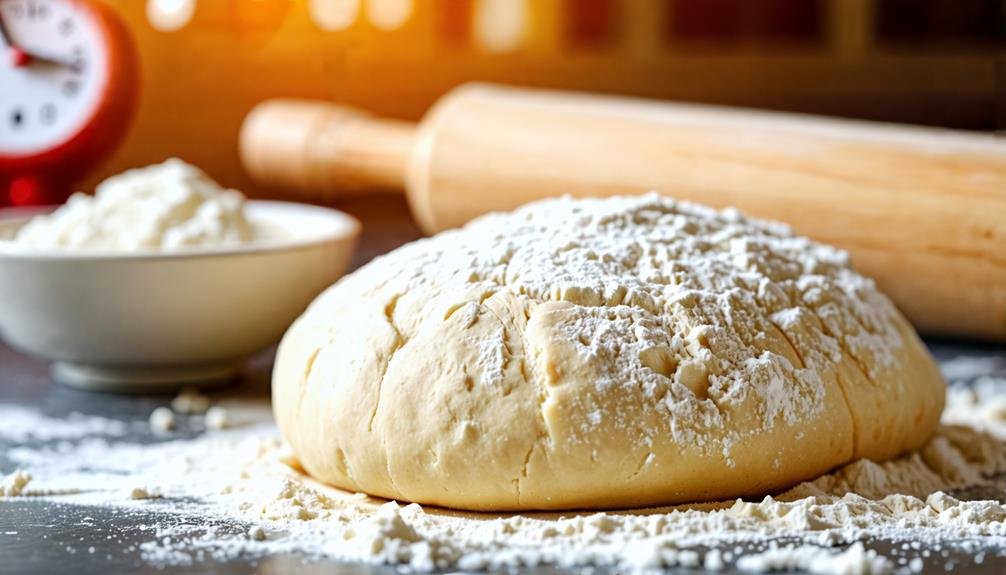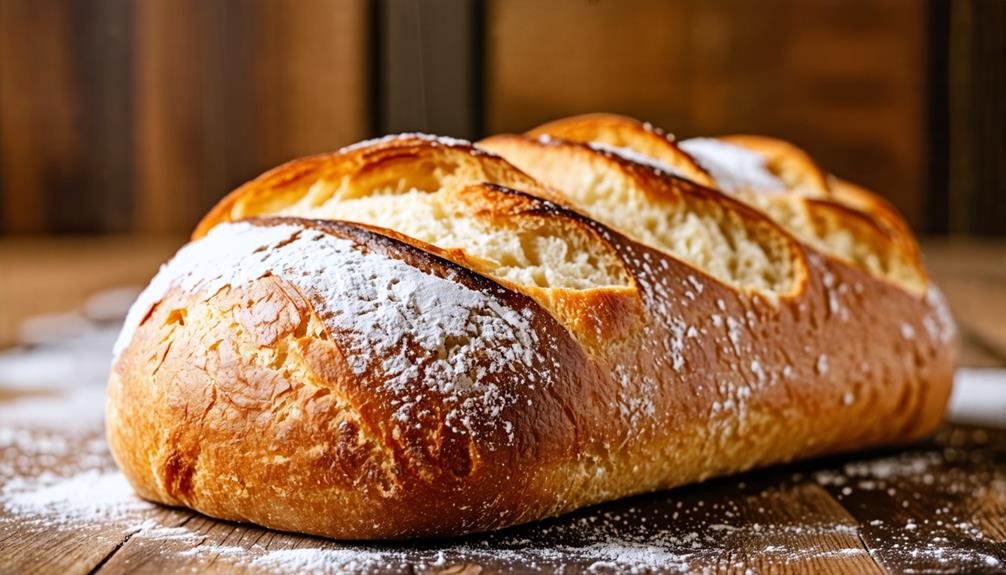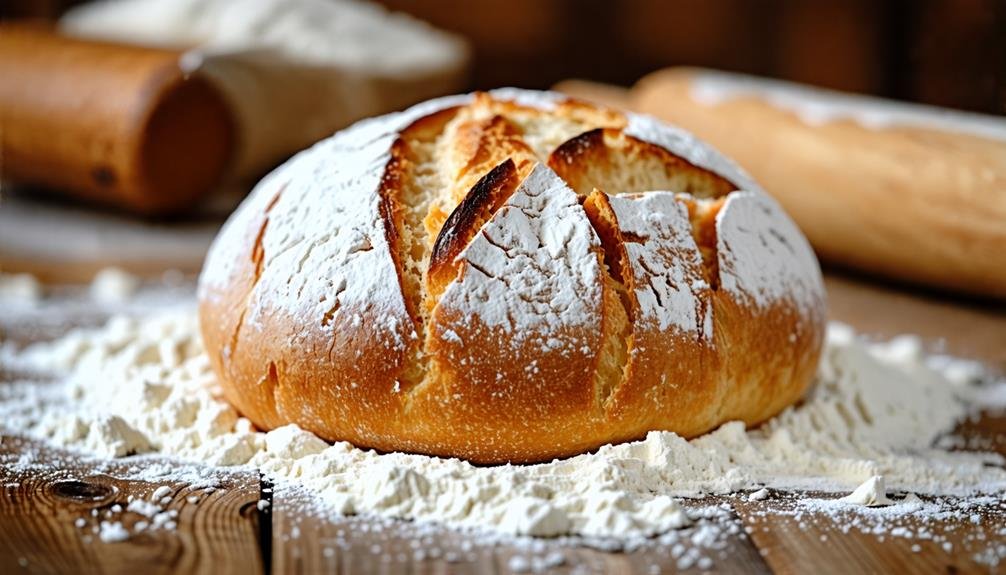If you've overproofed your bread, don't despair! Begin by gently pressing down the dough to release excess carbon dioxide. This allows you to reshape it, redistributing the yeast for a more balanced rise. Be mindful when handling delicate types like sourdough; they require a light touch. Subsequently, shape your dough to your desired form, ensuring to monitor the proofing time closely. If you're making brioche or pizza dough, you're in luck—these are particularly forgiving! With just a bit of care, your bread can still turn out delightful. Curious about specific techniques for different bread types? There's more to discover!
Understanding Overproofing Causes
Understanding the causes of overproofing is crucial for bakers aiming for excellent bread quality, as too much carbon dioxide production during fermentation can cause dough collapse. Yeast, a key ingredient, transforms carbohydrates into carbon dioxide, prompting the dough to rise. However, when proofing exceeds the recommended duration—typically between 30 minutes and overnight—bakers may face common bread baking errors.
Temperature, a significant environmental factor, can speed up fermentation, resulting in overproofed dough. To avert this issue, bakers should use a timer to track proofing time and gently poke the dough to assess its readiness. Effective bread troubleshooting techniques can help bakers rescue their creations. If overproofed dough occurs, there's no need to panic! Techniques for overproofed bread include punching or flattening the dough to expel excess air, particularly for forgiving bread types like brioche and rye.
Prevention Techniques for Proofing
Effective prevention techniques for proofing are essential for achieving high-quality bread and avoiding the issues associated with overproofing. First, monitoring your dough is crucial. A simple poke test—gently pressing your finger into the dough—can indicate readiness. If the indentation slowly springs back, you're in the ideal range!
Using a timer is equally vital. Proofing durations can differ significantly, so tracking ensures you maintain awareness of your dough's development. Pay attention to environmental factors, as temperature and humidity can significantly influence proofing pace. Ideally, keep the temperature below 77 degrees Fahrenheit to curb yeast activity when needed.
Refrigeration is a smart tactic, especially for extended proofing periods. It enables a gradual rise, enhancing flavor while preventing overproofing. Embrace the opportunity for experimentation by adjusting your proofing conditions according to the specific recipe and your surroundings.
Steps to Fix Overproofed Dough

Restoring overproofed dough involves precise methods to revitalize its form and taste. Begin by gently pressing down the dough to release the excess carbon dioxide that has built up. This helps reshape the dough, allowing it to regain some structure. After deflating, lightly knead the dough for a few minutes to redistribute the yeast and create a more uniform texture.
Next, reshape the dough based on your desired bread type, whether it's a classic French baguette or a rustic country loaf, and let it proof again—this time with close attention. Keep an eye on the dough, looking for signs of proper rise without surpassing the optimal proofing duration. If you're working with sensitive types like sourdough, be cautious not to over-deflate during shaping. Instead, consider scoring the surface to facilitate controlled expansion while baking.
Types of Bread You Can Salvage
Certain varieties of bread can be saved after overproofing, allowing bakers to reclaim their efforts and produce a satisfactory final product. Among these, brioche and rye bread stand out for their forgiving nature. If your brioche has overproofed, a gentle deflation can restore its structure, enabling you to reshape and proof it again for a delightful outcome.
Pizza dough also accommodates some overproofing. A quick punch down allows you to reintroduce elasticity, paving the way for a delicious crust that's just begging to be topped with your favorite ingredients. Sourdough, however, requires a bit more finesse; while it can be salvaged, care must be taken during the subsequent proof to avoid collapse.
These forgiving breads offer a sense of freedom, reassuring bakers that not all is lost when faced with overproofed dough. By adhering to proper handling techniques, you can navigate the nuances of each type and still create a loaf that brings joy and satisfaction. Remember, baking is as much about creativity and exploration as it is about precision, so welcome the adventure and relish the chance to turn a baking mishap into a triumph!
Impact of Overproofing on Quality

Overproofing negatively affects the quality of bread, resulting in undesirable traits like flatness and heaviness. When dough undergoes excessive fermentation, the overproduction of carbon dioxide weakens its structure, leading to a loaf that lacks the desired light and airy texture. Instead of a beautifully risen product, bakers may end up with a dense, heavy mass that fails to rise in the oven, leaving a sense of disappointment.
Additionally, the dough's structural integrity diminishes significantly. Overproofed bread may split in the oven, creating unsightly cracks that detract from its visual appeal and impact the overall taste. The once-promising aromas and flavors can turn dull, resulting in a loaf that lacks the rich complexity sought by bakers.
Grasping the art of proofing is essential for any aspiring baker. By recognizing the signs of overproofing and adjusting techniques, bakers can rediscover the joy of creating. Remember, it's not solely about the final product; it's about the opportunity to experiment, learn, and refine your skills in the kitchen.









